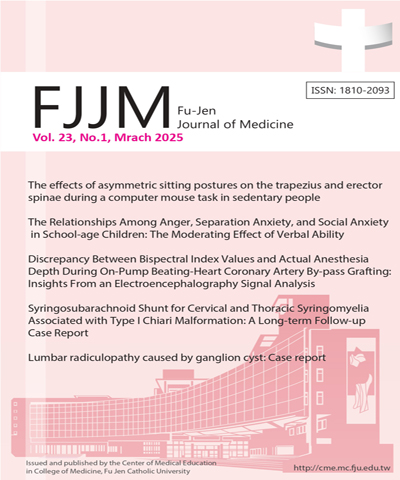
輔仁醫學期刊/Fu-Jen Journal of Medicine
輔仁大學醫學院,正常發行
選擇卷期
- 期刊
Background and Purpose: Light-induced retinopathy is an animal model that mimics the photoreceptor apoptotic progress in retinal degeneration. This study examines the effects of human amniotic membrane mesenchymal stem cells (hAM-MSCs) on a light-induced animal model. Methods: Male Sprague-Dawley (SD) rats were exposed to 5000 to 7 000 lux for 7 d and treated with hAM-MSCs. The functional changes of the retinas were monitored by electroretinogram (ERG). Frozen retinal sections were analyzed for histology and immunohistochemistry. Results: Severe damages presented, including a large number of apoptotic cells on the ONL, a decrease in the ONL thickness, and the reduction of ERG following 7 d of light exposure. Retinal structure and function were recovered following treatment with hAM-MSCs, and the grafted hAM-MSCs were differentiated into retinal pigment epithelium cells (RPE), photoreceptors, and Müller cells. The transplantation of the hAM-MSCs improved the retinal function and morphology, and the hAM-MSCs differentiated into retinal cells. Conclusion: These findings show that hAM-MSCs may be possibly used to treat retinal degenerative diseases.
- 期刊
There are few preliminary studies and reviews of non-intubated thoracic surgery (NITS) in recent years considering its feasibility and safety. Anesthetic management also became an issue due to lack of standard protocol and wide range of surgical procedures. The case we presented is a 45-year-old male, who had systemic sclerodermatitis, suffered from recurrent spontaneous pneumothorax because of huge bullae formation in the lung. The patient underwent bullectomy via non-intubated video-assisted thoracoscopy with local anesthesia and neuroleptanesthesia successfully. He had fast recovery from surgery, which allowed early rehabilitation. Here, we share our anesthetic experience and review other current management.
- 期刊
We reported a rare but deadly case of massive spontaneous omental bleeding. This 40 year-old male who did not have any specific past medical history and any known cardiovascular risk factors, presented with decompensated hemorrhagic shock and respiratory failure. After resuscitation, he was successfully managed with emergent laparotomy and partial omentectomy. Pathology revealed focal septic emboli in multiple ruptured omental arteries associated with acute and chronic inflammation. Patients with stable vital signs should receive confirmatory CT scan followed by transarterial embolization if available, whereas patients with unstable vital signs should undergo immediate exploratory laparotomy.
- 期刊
Pituitary apoplexy is an uncommon but well-known condition that leads to acute deteriorated neurological and endocrinal deficits. However, subarachnoid hemorrhage and intraventricular hemorrhage resulting from pituitary apoplexy are rarely reported in the literature. We reported a 75-year-old female presenting with severe headache and visual impairment. Magnetic resonance images of the brain revealed a pituitary macroadenoma. Acute deteriorated neurological deficits developed after admission during the correction of hyponatremia. The computed tomographic scan of the brain revealed pituitary apoplexy with diffuse subarachnoid hemorrhage and intraventricular hemorrhage. The relevant literature is reviewed.
- 期刊
Massive fetomaternal transfusion (FMT) causes serious anemia, induces fetal/neonatal shock and asphyxia, and increases the risk of death or hypoxic-ischemic encephalopathy (HIE) in the neonate. Therapeutic hypothermia delays anoxic brain cell damage by suppressing tissue inflammation, intracellular signaling, and programed cell death; thus, it is neuroprotective in the neonatal brain with perinatal asphyxia. Therapeutic hypothermia is currently the standard of care for neonates with HIE. We report a neonate with life-threatening anemia and HIE caused by massive FMT who was successfully treated with therapeutic hypothermia. This newborn presented with birth asphyxia, general hypotonia, undetectable blood pressure, marked metabolic acidosis, profound anemia (hemoglobin = 2.0 g/dL), and stage 2 HIE. Therapeutic hypothermia with a target temperature of 33°C was initiated at the age of 4 h for a total of 72 h. A Kleihauer-Betke test of maternal blood was positive and the estimated blood loss from the fetus to the mother was approximately 240 mL. He was extubated on day 7, and the general activity, muscle tone, and oral feeding improved gradually. The hearing test revealed normal hearing bilaterally. Neurological development at 4 months of age was not delayed. Therefore, therapeutic hypothermia should be a choice for the treatment of critical newborn infants with massive FMT complicated with HIE.
- 期刊
Glioblastoma multiforme (GBM) is the most common and aggressive primary central nervous system tumor with the worse prognosis. Surgical intervention following radiotherapy and chemotherapy is the standard treatment modality for GBM patients. Temozolomide (TMZ), a newly developed alkylating agent, is an effective chemoagent and confirmed to be benefit for patients survival. O6-methylguanine-DNA methyltransferase (MGMT) protein expression confers the TMZ-induced cytotoxicity, which lead to failure of TMZ therapy. Previously, the methylation of MGMT promoter gene is developed to predict the expression of MGMT protein because of the difficult identification in immunohistochemical staining. However, the MGMT expression between protein and methylation status of promoter gene is discordant, and microRNA is discovered to play an important role in the post-transcriptional regulation. Therefore, we summarize the exact roles of microRNA in the regulation of MGMT expression in GBM cell lines or tissue samples from the literatures, which may provide the further clinical application including prognosis prediction, chemo-sensitivity or therapeutic treatment.

